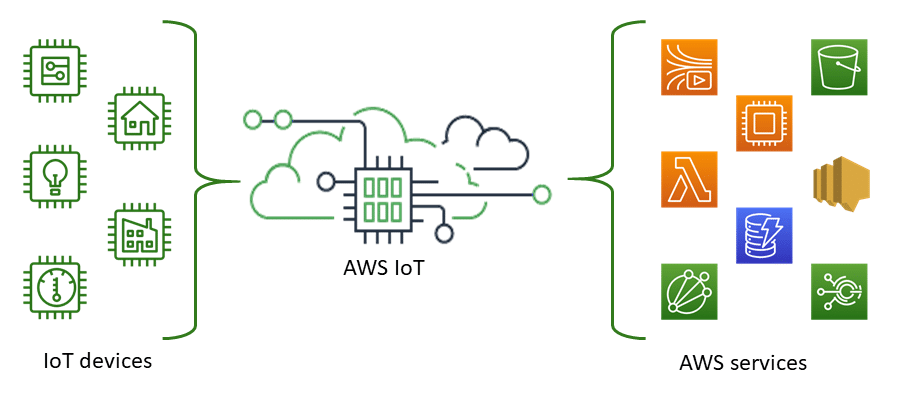Transforming Business Operations with AWS IoT: A Comprehensive Guide for Startups

In the digital age, the Internet of Things (IoT) is reshaping business operations by providing exceptional connectivity and efficiency. AWS IoT, a central element of Amazon Web Services, offers strong cloud services. It connects the IoT devices with other devices and AWS cloud services; these enable seamless interaction between the physical and digital worlds. To startups, AWS IoT presents an opportunity to leverage this technology to improve their operational efficiency and customer experiences and scale operations effectively. This article looks at the functionalities of AWS IoT, benefits, and integration strategies that can empower startups to change their business operations.
Table of Contents
What is AWS IoT Core?
AWS IoT Core is one of the crucial components of Amazon Web Services, designed to help connected devices and cloud applications interact easily and securely. This robust managed cloud platform is engineered to accommodate a vast network, capable of supporting billions of devices and handling trillions of messages efficiently. AWS IoT Core ensures not only reliable and secure message routing to both AWS endpoints and other devices but also continuous communication with all the connected devices, thereby improving operational continuity. This would come in very handy, especially in applications that keep track of the real-time status or act upon device data while some devices are offline. Scalability and the security features of this platform make it an indispensable tool for businesses looking to innovate and expand their IoT capabilities.
Understanding AWS IoT
IoT is a broad platform for the secure interaction of connected devices with cloud applications and other devices. AWS IoT Core lets startups connect their devices to the cloud without managing servers, which in turn, facilitates real-time data exchange and management. This service supports several communication protocols critical for IoT operations, like MQTT (Message Queuing and Telemetry Transport), MQTT over WSS (Websockets Secure), HTTPS (Hypertext Transfer Protocol – Secure), and LoRaWAN (Long Range Wide Area Network).
These protocols enable many IoT devices, from simple sensors to complicated industrial equipment, to communicate with the AWS cloud in a strong and safe way, ensuring data is transferred efficiently across the network. In addition, the message broker of the AWS IoT Core handles the MQTT and HTTPS protocols for publishing and subscribing to messages, thus further enhancing the flexibility and responsiveness of the system.

AWS IoT: Key Features
AWS IoT presents a set of features that cater to the various needs of startups. They include the following features:
- Device Connectivity and Management: The AWS IoT Core facilitates easy connection and management of many IoT devices. This allows startups to grow their operations without worrying about the underlying infrastructure.
- Security: AWS IoT provides very tight security mechanisms that guarantee safe device connection and safe data transfers through mutual authentication and end-to-end encryption, hence making it difficult for the data to be accessed by unauthorized users.
- Data Processing and Action: It enables the processing of data in real-time and action at the platform of startups to make decisions based on the most up-to-date information coming from their IoT devices.
Benefits of AWS IoT for Startups
Incorporating AWS IoT into a startup’s operational framework can bring forth immense benefits:
- Scalability: AWS IoT’s infrastructure is designed to support billions of devices and trillions of messages, thereby allowing startups to scale operations efficiently with growth.
- Cost Efficiency: Reducing the need for physical infrastructure and the management overhead for startups, AWS IoT can help reduce operational costs.
- Innovation: With AWS IoT, startups can rapidly develop and deploy new IoT applications and services, thereby keeping ahead in competitive markets.
Integrating AWS IoT Key Steps
- Setup: First off, startups need to ensure their IoT devices are AWS IoT-compatible and can communicate via supported protocols.
- Use AWS IoT SDKs: AWS offers IoT Device SDKs to help developers build applications on devices that interact with AWS IoT. These SDKs make the development process easier, simplifying how one sends and receives messages from the cloud.
- Manage Devices with AWS IoT Core: After setting up devices, startups can use AWS IoT Core to manage and monitor their device fleet—this includes registering devices, setting up certificates, and defining policies for secure communication.
Challenges and Best Practices
While AWS IoT offers several advantages, startups may face challenges with data privacy, integration of legacy systems, and the complexity of IoT deployments. In order to address these challenges, startups should:
- Focus on Security: Implement strong security practices from the outset, including regular audits and compliance checks.
- Leverage Professional Assistance: Consider partnering with AWS experts or consultants who can provide guidance and support throughout the integration process.
- Start Small: Begin with a pilot project to learn about the intricacies of AWS IoT before fully integrating it into all operations.
Conclusion
AWS IoT heralds an opportunity for transformation in startups that seek technological capability enhancement and operational efficiency. By grasping and harvesting the powerful features of AWS IoT, a startup is not only streamlining operations but also opening new paths of innovation and growth. With a view to this rapidly changing landscape of technology, AWS IoT is surely going to play a significant role in shaping the future of connected business operations.


